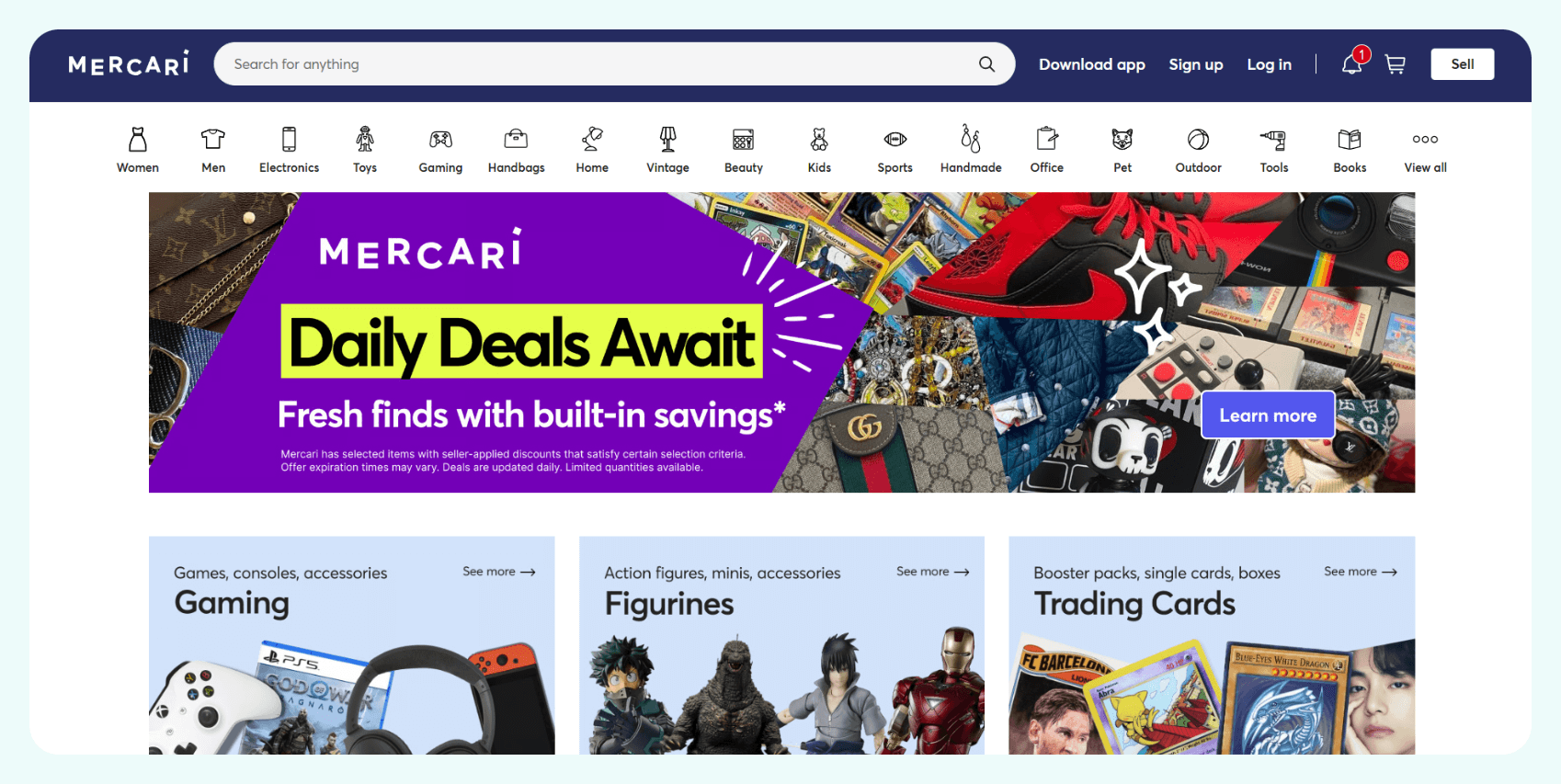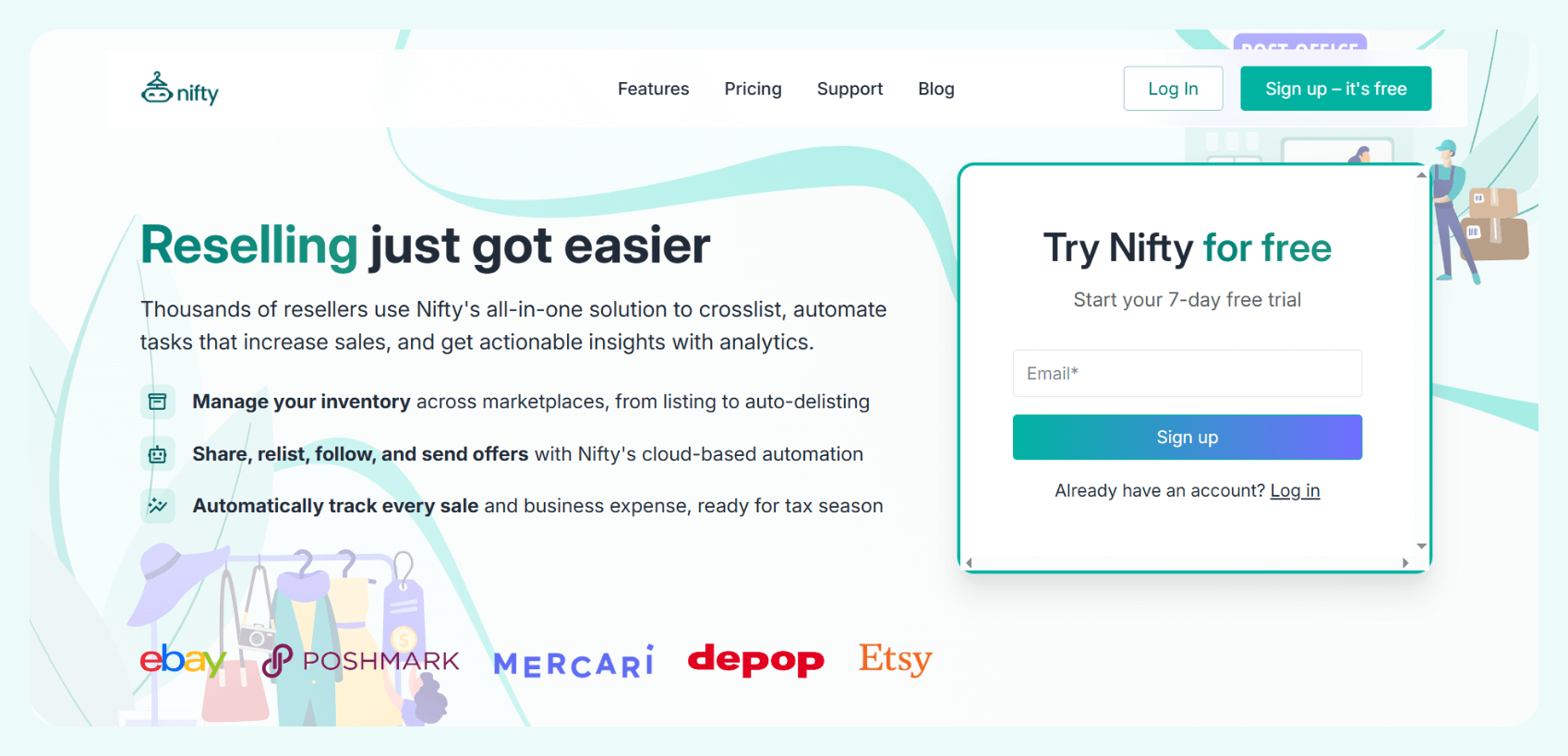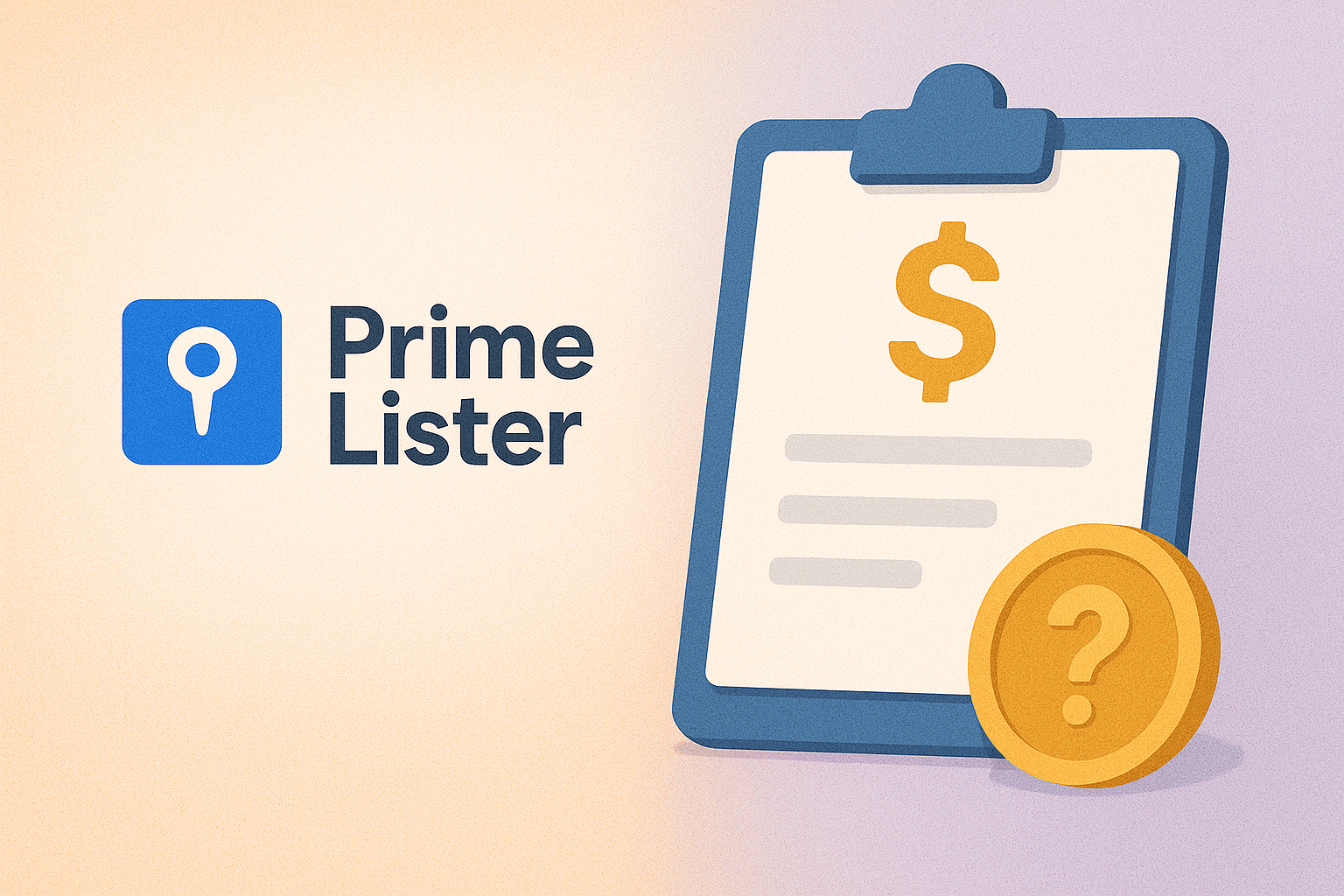Selling on Mercari vs. eBay: Which platform is better for profits?

Mercari suits casual sellers seeking low fees and fast payouts, whereas eBay delivers higher average sale prices for niche items.
For example, a stay-at-home parent flipping clothes, gaming consoles, and collectible toys may earn more consistently on Mercari, but a sneaker reseller with international buyers will scale faster on eBay.
In this article, we’ll compare selling on Mercari vs. eBay, break down fees, buyer behavior, and tools. We’ll also show you how Nifty helps you sell smarter, not harder, by allowing you to use Mercari and eBay together.
Mercari vs. eBay: What’s the real difference?
Mercari is a resale marketplace built for simplicity, while eBay is a global auction and fixed-price marketplace designed for reach. Sellers gain more traffic, higher sale prices, and better scaling tools on eBay. Mercari offers basic listing tools but enables faster setup, lower fees (generally), and quicker payouts.
Different types of sellers use Mercari vs. eBay for various goals. Side hustlers, casual sellers, or individuals decluttering their homes should opt for Mercari. On the other hand, sellers who treat reselling like a business, not a one-off or part-time side hustle, should choose eBay. They’re product flippers, vintage sellers, or business owners.
Let’s take a closer look at the differences between eBay and Mercari.
Selling on Mercari vs. eBay: At a glance
Mercari: Features & highlights

Mercari helps casual sellers and side hustlers transform products into cash. Individuals seeking a straightforward platform with simple listing rules will find Mercari accommodating. For instance, a college student can flip sneakers from local thrift stores, or a stay-at-home parent can sell outgrown kids’ clothes.
Best for
Mercari performs best in consumer goods resale categories, such as clothing, character merch, collectibles, toys, gaming accessories, and home products. It’s built for individuals and micro-sellers who are cross-listing and want to list items quickly and get paid with minimal setup.
Solo flippers, part-time resellers, and casual declutterers find Mercari ideal for moving inventory without the overhead of store management. Sellers without technical skills or marketing budgets will find the platform especially useful: These sellers rely on speed, app visibility, and price competitiveness to make quick sales.
Strengths
- Relatively low fees: Mercari charges no listing fees, and you keep more of what you earn, as you only pay a 10% commission.
- Fast payouts: Mercari processes funds on the next business day after the buyer confirms delivery. Direct deposits typically reach your account within 1 to 2 business days, with 5 business days being the maximum.
- Optimized for mobile: List products, negotiate pricing, and ship directly from your phone in under 10 minutes. Mercari simplifies uploading photos, setting prices, printing shipping labels, and chatting with buyers all from a single device.
- Fast-moving marketplace: Mercari attracts deal-seeking buyers, which helps sellers move items fast when priced competitively. If you price to sell, expect fast turnover, especially for categories like fashion, video games, and collectibles with built-in demand.
Weaknesses
- Limited to the U.S. market: Mercari does not support international sales or delivery. So if you’re hoping to scale or catch the latest G-Dragon trend in Asia, you’ll need to list elsewhere.
- Waterfall offers hurt margins: Each time you send a new offer on Mercari, you're forced to lower your price by at least 10%, even if the original liker hasn't accepted. Use Nifty, and you can avoid this.
- Low-price culture = lower margins: Mercari’s buyer base expects low prices and quick shipping. This can lead to price wars between sellers, making it challenging to generate substantial profits.
- Recent fees for buyers could hurt margins: Beginning in January 2025, Mercari started charging buyers a 3.6% buyer protection fee and added a $3 fee for instant seller payout. Sellers have complained that these fees hurt their bottom line.
eBay: Features & highlights

Since 1995, eBay has connected sellers to international markets. It offers powerful search and flexible tools. eBay is ideal for serious resellers, small businesses, and niche product sellers aiming to scale.
Best for
Collectors and serious buyers drive sales for high-intent items on eBay. These products include refurbished electronics, auto parts, vintage goods, rare collectibles, and discontinued SKUs.
eBay suits a variety of sellers and operations, from startup entrepreneurs to Fortune 500s looking to sell inventory to global customers who can haggle.
Strengths
- International marketplace increases your buyer pool: eBay’s global marketplace connects sellers with over 130 million active buyers worldwide.
- Flexible formats for controlling pricing strategy: Sellers can choose between fixed-price listings or auctions. Auctions are ideal for rare or high-demand items, while “Buy It Now” listings work for volume or replenishable SKUs. eBay also allows best offers and bulk discounts.
- Tools for scaling: Sellers can manage listings, communicate with buyers, and track inventory workflows with eBay’s Seller Hub, automated messaging, Terapeak product research, and third-party integrations. Inventory tracking, CSV bulk uploads, and campaign management features help sellers stay organized and competitive.
- Promoted listings and insights for optimal visibility: eBay offers built-in advertising through its Promoted Listings feature, helping listings rank higher in search.
Weaknesses
- The fee structure gets complicated: eBay charges fees based on category, plus optional store subscriptions, promoted listings, and per-order surcharges. For instance, eBay takes a 15.3% fee for books, DVDs, and music, but a 13.6% fee for auto parts and accessories. It also charges listing and store subscription fees, which vary.
- Returns and policies tend to support buyers: eBay’s Money Back Guarantee and return policies heavily favor the buyer, even in cases of dispute. eBay requires sellers to accept returns on most items and can remove protections if sellers fail to meet deadlines.
- Slow payouts: eBay holds funds until it confirms delivery or the set time period passes. Unlike platforms with instant or near-instant payouts, eBay’s rolling payment model can disrupt restocking or reinvestment.
- Crowded and competitive platform: Millions of sellers flood eBay across every category. Gaining traction requires aggressive pricing, strong feedback, and SEO-optimized listings.
Mercari vs. eBay: Feature-by-feature comparison
If you’re trying to decide whether your listings belong on Mercari and eBay, consider how each delivers the following features:
Listing experience
A platform’s listing experience influences how sellers handle updates. Platforms that reduce clicks and offer mobile-friendly tools help users move inventory faster. Sellers need quick posting from their phone, easy relisting when items expire, and tools that don’t overwhelm them.
Mercari and eBay offer very different listing flows.
eBay
eBay offers advanced listing tools with AI capabilities. Sellers still enter item specifics, shipping options, and return settings, but eBay’s mobile app speeds up the process. Sellers start with a photo and title, and eBay’s AI fills in product details and category suggestions automatically.
eBay released this AI tool in April 2025. Some users claim it enters inaccurate info, so you should always check each AI-generated listing before publishing.
On desktop, sellers get full access to listing templates, business policies, and bulk tools through Seller Hub. The mobile app supports bulk listing, making it easy to manage listings on the go. eBay allows sellers to manage listings in bulk through CSV uploads, but you’ll need to overcome the learning curve.
eBay's detailed category rules and upsells often overwhelm new and casual sellers. On the other hand, backend tools and customization options give high-volume sellers clear advantages.
Mercari
Mercari simplifies and speeds up the listing process. The platform has released an AI tool that can import products and automatically generate titles and descriptions. However, users have complained that the AI mislabels products and creates duplicates.
Manually posting a new item takes under five minutes, with minimal required fields, like photos, title, condition, category, and price. The mobile app is the primary way most sellers list, and it outperforms the desktop version in both speed and usability.
That said, the app’s intuitive design and straightforward flow make it easy for new users to start selling without tutorials or setup headaches. For low-maintenance reselling, Mercari supports quick listing. It’s perfect for sellers who prioritize ease of use over backend control.
The verdict
When it comes to listing manually, Mercari wins due to its speed, simplicity, and mobile-first design.
According to the user reviews we found, eBay’s AI tool outperforms Mercari’s. But users still complain that both tools generate inaccurate output. This means you should still expect to manually enter listing data to avoid errors.
For new sellers and quick listers, Mercari outperforms in time to post, mobile usability, and ease of use. However, if you’re considering scaling your selling operation, you might want to consider eBay, as it’s geared towards higher-volume sellers. Or, use both and crosslist with Nifty.
Fees and payouts
Fees and payouts directly impact how much profit sellers take home, so understanding the full cost is essential. Mercari employs a flat-rate approach, paying out as soon as the buyer confirms delivery. In contrast, eBay charges different rates that depend on the product, in addition to final value fees. Sellers often wait several days for payouts.
Mercari
Mercari keeps its fee structure simple. Sellers pay a 10% selling fee per transaction. It doesn’t charge listing fees.
Payouts are typically faster than platforms that rely on delayed processing or fixed schedules. Sellers stay on top of earnings with clear transaction-level fee breakdowns.
However, optional services like promotion fees or shipping add-ons can still impact net profit. Tools like Nifty can track profits by aggregating fees, shipping costs, and revenue from platforms like Mercari, eBay, and others, all on one platform.
eBay
eBay has a more layered fee structure compared to Mercari. Sellers generally pay a final value fee of 10–15%, depending on the category, plus $0.30 per order in payment processing fees. For sales exceeding $7,500, eBay charges an additional 2.35% on every dollar above $7,500.
It allows up to 250 free listings per account. eBay takes an additional $0.35 from every listing over 250.
The platform provides fee breakdowns, but finding their exact location on eBay’s complex dashboard is difficult. Thus, high-volume sellers struggle to calculate profits due to this complexity.
eBay initiates payouts within 1–3 business days of confirming payment. Actual bank deposit times may vary depending on the seller’s payout schedule (daily, weekly, etc.) and bank processing speed. However, funds aren’t available instantly.
The verdict
Mercari wins on fees and payouts thanks to its zero insertion fees, flat-rate pricing, and faster payout timing once the buyer confirms delivery. Unlike eBay’s complex fee tiers and listing charges, Mercari’s transparent structure makes it easier to predict profits.
Buyer behavior
Buyer behavior refers to how shoppers interact with a platform: What they look for, how they evaluate trust, and what kind of experience they expect.
Mercari buyers tend to value speed, simplicity, and low-effort shopping. eBay buyers often hunt for deals, rare finds, or high-value items, and they expect details.
Mercari
Mercari attracts casual shoppers seeking deals on everyday essentials, affordable fashion, and household goods. Buyers on Mercari often have an item in mind and want it at a bargain price. The platform does include a “Make an Offer” button, allowing negotiation, but haggling is less central to buyer behavior than on eBay. Sellers can even choose to decline offers.
Buyers expect clear photos, accurate item descriptions, and prompt shipping, with minimal back-and-forth. Feedback matters, but it plays a lighter role in purchase decisions compared to eBay. Buyers mainly rely on shipping reliability and item condition to determine trust.
Overall, Mercari supports a low-effort shopping experience, with buyers aiming for convenience over interaction.
eBay
eBay attracts a wide range of buyers, from seasoned collectors to casual deal-hunters. They’re often searching for specific items, rare goods, or discounted brand names. These shoppers typically expect detailed listings with multiple photos, full item specifics, and clear return policies.
eBay’s interface encourages negotiation through its “Make Offer” feature, and many buyers actively engage in haggling, especially in collectible or electronics categories. Feedback plays a role in buyer trust: Users check seller ratings, number of completed sales, and buyer reviews before committing to a purchase.
Buyers on eBay also expect prompt responses and fast shipping. The platform rewards consistent performance with Top Rated Seller status, which many buyers use as a quality signal.
Overall, eBay’s buyer base is more engaged, feedback-driven, and price-conscious than that of many other resale platforms.
The verdict
eBay wins for buyer behavior due to its active, engaged buyer base, strong feedback culture, and built-in trust signals. Buyers come to eBay with specific intent, expect detailed listings, and frequently use the Make Offer tool to negotiate.
The platform fosters a transparent community where ratings, return policies, and seller history play a crucial role in building trust, making it ideal for sellers seeking motivated, informed shoppers.
Shipping and returns
Shipping and returns policies shape how sellers manage risk, costs, and customer satisfaction.
Seller protections vary. eBay has policies in place, but often sides with buyers in disputes, whereas Mercari requires buyers to confirm delivery before release of funds.
Mercari
Mercari simplifies shipping by offering prepaid labels with flat rates based on item weight. Sellers can choose from USPS, UPS, and FedEx options, or offer their own shipping method. The platform calculates shipping rates based on weight and the selected carrier.
In terms of seller protection, Mercari holds buyer payments in escrow until the buyer confirms receipt of the item and verifies that it matches the listing.
Mercari only approves returns when a buyer files a dispute and provides evidence. Overall, Mercari performs well for sellers who value ease and built-in support.
eBay
eBay offers flexible shipping options, allowing sellers to select carriers such as USPS, UPS, and FedEx. They can set their rates or offer free shipping. Sellers can purchase discounted shipping labels directly through eBay, which includes tracking and optional insurance.
In terms of protection, eBay provides seller safeguards. This includes protections against damaged returns and authenticity services. Return policies vary by seller, but buyers can request returns within the specified window, often 30 days.
The verdict
Mercari wins for shipping and returns due to its prepaid label system, simple flat-rate pricing, and built-in escrow protection. Sellers don’t need to manage shipping settings or calculate rates, and returns are only accepted for misrepresented items.
Seller tools and automation
Seller tools and automation shape how sellers manage listings, adjust prices, and scale their business. Mercari takes a simpler approach with a basic interface focused on mobile use and ease. eBay gives sellers access to Seller Hub, a powerful dashboard with bulk listing tools, business policies, and detailed analytics.
Mercari
Mercari offers a limited toolset when compared to eBay. Most sellers list and manage items using the mobile app. Its standout feature is auto-drop pricing, which automatically reduces an item’s price over time to increase visibility and drive interest.
However, Mercari lacks proper bulk listing tools. Sellers must adjust each listing manually, which can slow down high-volume workflows. There’s no Seller Hub equivalent, and features like templates, CSV uploads, or automation rules are not available natively.
Sellers can use a tool like Nifty to overcome these challenges. Nifty fills these gaps on reseller websites by enabling crosslisting across platforms, applying bulk actions, and auto-delisting items once they sell.
eBay
eBay offers a large seller toolset, featuring Seller Hub. This functionality gives users performance analytics and inventory management tools. It also supports bulk actions, including listing uploads via CSV, automated pricing rules, and shipping templates.
Its interface details every aspect of a listing, from shipping preferences and return policies to item specifics and buyer requirements. This gives sellers full control over how products appear and are sold.
Compared to Mercari’s basic interface and auto-drop pricing, eBay requires more setup. Although eBay offers greater automation and performance visibility, it may overwhelm beginners.
The verdict
eBay is the winner with its Seller Hub, bulk listing tools, CSV support, and automation features. Mercari does have a simpler interface, but it lacks tools for scaling.
User reviews: What real sellers are saying
We reviewed seller feedback from sources like Trustpilot, Reddit threads, and the Better Business Bureau to understand how Mercari and eBay perform in the real world. Sellers shared insights on platform ease, payment reliability, customer support, and growth potential.
Overall, experiences varied by seller type and volume. Users reported consistent patterns in support quality, payout timing, and listing management.
Mercari: What users think
We found that sellers use Mercari to list items quickly, attract casual buyers, and avoid the complexity of platforms like eBay. However, some Mercari sellers criticized the platform for not handling complaints.
Pros
- No listing fees, user-friendly: On Trustpilot, a seller said that Mercari is more seller-friendly than eBay and Amazon because it doesn’t charge any listing fees.
- Consistent customer service: A seller credited Mercari with providing a platform that gave reliable earnings for years.
- Simple listing: A Trustpilot user praised Mercari for making it easy to list items and earn money fast.
Cons
- Weak seller protection: One reviewer on the Better Business Bureau complained that Mercari overcharged them for shipping fees when a buyer fraudulently claimed the package weighed more than the seller originally stated.
- Difficult to make low-price sales: A Mercari user reported on Trustpilot that he couldn’t make any sales, because buyers didn’t want to pay the prices he was offering.
- Low traffic makes selling difficult: A Reddit user said that while you pay fewer fees on Mercari, you get less traffic than on other platforms and poor customer support.
eBay: What users think
Pros
- More sales income: Even though eBay charges higher fees than Mercari, one Redditor said he prefers eBay because he can sell higher volumes, thereby increasing his income.
- Customer service has improved: An eBay veteran who’s used the platform for over 20 years claimed on Consumer Affairs that eBay’s customer service is helpful, reliable, and knowledgeable.
- Seller Hub is actually helpful: On the eBay Community forum, an eBay seller posted that Seller Hub simplifies navigating the user interface.
Cons
- Multiple fees can add up: On Reddit, a user explained that they sold a GoPro for $775, but, due to eBay’s fees, they only made $530 in profit. That’s 31% in fees.
- Biased in favor of buyers: A user on Trustpilot said that every time they’ve had an issue with getting a return, eBay took the side of the buyer.
- Slow payouts: A seller on the Better Business Bureau noted that eBay failed to deposit the funds into their checking account after the buyer received the package. Another seller lodged a similar complaint.
How to make your choice
Choosing between Mercari and eBay comes down to your goals, inventory size, and selling style.
Choose Mercari if:
- You want to list quickly: Mercari offers a design that suits sellers who value speed and simplicity. You can snap a photo, write a short description, and post an item in under 5 minutes, right from your phone. The mobile app handles everything from shipping labels to buyer communication, allowing you to list and ship without switching devices.
- You’re new to casual selling: Mercari is ideal for beginners looking to clean out closets or flip a few finds for extra income. You don’t need to learn complicated dashboards, subscribe to a store plan, or manage bulk listings. If you’re not ready for a long-term commitment or overhead, Mercari offers a low-risk way to try reselling.
- You want predictable fees and fast payouts: Mercari’s flat-rate 10% commission fee makes earnings easy to track. After a buyer confirms delivery, Mercari releases funds as soon as the next business day.
Choose eBay if:
- You flip collectibles, oddities, or high-volume goods: eBay supports sellers who list niche, rare, or high-value inventory. If you deal in vintage toys, retro electronics, or discontinued parts, eBay’s auction format helps you fetch better prices. It also suits collectibles selling, where bidding wars and targeted demand drive profit.
- You’re selling internationally: eBay opens your listings to buyers in over 190 countries, making it ideal for global sellers or anyone with a shippable niche. Whether it’s Japanese vinyl records or European bike parts, eBay’s international shipping options help you tap into hard-to-reach buyer pools outside the U.S.
- You want advanced seller tools: You can schedule listings, apply bulk edits, and track performance from the Seller Hub. eBay offers built-in advertising through Promoted Listings, which helps boost your products in search results. You control how much you spend and which listings to promote.
Bottom line: Mercari is best for fast, low-effort reselling with minimal overhead, whereas eBay caters to sellers aiming to scale, reach global buyers, or move niche inventory. Consider your product type, desired workload, and growth goals.
You don’t need to choose: Crosslist with Nifty

Can’t decide between Mercari vs. eBay? Stop straining your brain and manage both on one platform with Nifty. It brings your Mercari and eBay listings into a single, easy-to-manage interface so you avoid duplicate work. Here’s what else you get with Nifty:
- AI-powered listings in seconds: Upload a photo and Nifty will generate SEO-friendly titles, detailed descriptions, and trending hashtags.
- Crosslist with other platforms: Nifty also supports crossposting across Poshmark, Depop, and Etsy, keeping your inventory updated and auto-delisting items from all platforms once they sell.
- Relist, schedule, and discount in bulk: Running sales or clearing stale listings? Nifty handles it all. You can bulk-edit prices, schedule updates, and queue up relists while you focus on sourcing or shipping. Your storefronts stay active even when you're offline.
- Track your profits across platforms: Get real-time insights on sales, fees, and performance in one clean dashboard. Spot your best sellers, identify dead weight, and make smarter decisions based on precise, up-to-date data.
Start with a 7-day free trial and see why resellers are using Nifty to simplify operations and maximize profits.
FAQs
1. What is Mercari?
Mercari is a mobile-focused online marketplace where individuals can easily sell secondhand items like clothes, electronics, and household goods to other consumers. The platform makes reselling simple and accessible for casual sellers who want to quickly turn unwanted items into cash. Mercari takes a flat 10% fee on every sale.
2. Is Mercari or eBay better for beginners?
Mercari is a legit platform that’s better for beginners who want a fast and hassle-free way to start selling. It’s mobile-friendly, has fewer listing requirements, and doesn’t overwhelm you with features. You can list an item in minutes and avoid steep learning curves.
3. Which platform has lower overall fees?
Mercari generally has lower, more predictable fees than eBay. If you’re wondering how much Mercari takes, it charges a 10% selling fee per sale, with no listing fees. High-volume or niche sellers may find eBay’s higher fees worth it, but it’s less transparent upfront.
4. Can I use both platforms at once?
Yes, and many successful sellers do. Mercari is great for casual flips and everyday items, while eBay is a global marketplace with more seller tools. With a crosslisting tool like Nifty, you can post to both platforms simultaneously, sync inventory, and manage all your listings in one interface.
5. Which platform is better for international buyers?
eBay is better for international sales. It supports global shipping (which you must opt in for), offers currency conversion, and connects sellers to buyers in over 190 countries. Mercari is U.S.-only and doesn’t offer international shipping. If you’re trying to reach collectors abroad or build a global storefront, eBay gives you the infrastructure that Mercari simply doesn’t have.





